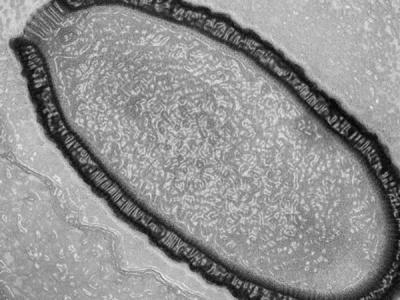How "Cheating" Slime Mold Escapes Death
Cells of the slime mold Dictyostelium discoideum sometimes join together to form a slug (pictured).
Cheaters do prosper—at least if you're a slime mold, a new study says.
The slime mold Dictyostelium discoideum, found in most warm parts of the world, has an unusual life cycle. Most of the time Dicytostelium cells are "happy" single cells that hang out and eat bacteria, according to study leader Lorenzo Santorelli of the University of Oxford, who conducted the research while at Rice University and Baylor College of Medicine.
But sometimes, when food is scarce, different strains of Dictyostelium, including a mutated strain, form a mobile, multicellular organism called a "slug." This cluster then sprouts a stalk called a fruiting body, which produces spores that disperse into new slime molds.
For a slug to produce a stalk, however, nearly 20 percent of its cells must die—essentially sacrificing themselves to pass on their genes. (Get a genetics overview.) The remaining 80 percent live on and become spores.
Now, for the first time, Santorelli and colleagues have figured out the mechanism by which the mutated strain is able to survive in higher numbers than the others.
It suppresses normal cells from becoming spores, thereby forcing more of these cells to sacrifice themselves for the stalk and die. Meanwhile, more cells in the mutated strain become spores—and thus avoid dying as stalk cells. In other words, more than the "fair share" of cheater cells see another day.
Cheating Cells Surprisingly Healthy
To make the discovery, the team mixed the cheater strain with normal strains and observed that more cells in the cheater strain live on.
On one hand, this isn't all that surprising, Santorelli noted: "Cooperation is always under attack in any organism—trying to get something for [yourself], it's just nature."
But what is striking, he said, is that usually cheaters eventually cause the entire cooperative system to collapse. Not so in Dictyostelium—somehow it's evolved a way to keep everything running smoothly, said Santorelli, whose study was recently published in the journal BMC Evolutionary Biology.
What's more, cheaters are usually weaker than cooperative individuals. But not in Dictyostelium cheaters, which appear to be quite healthy.
Santorelli wants to find out how the cheater strain is so successful. And, just maybe, the lowly slime mold could unravel the evolutionary and genetic basis for cooperation, he added.
"Slime mold is an amazing organism."
Christine Dell'Amore
National Geographic News
Published January 10, 2013












